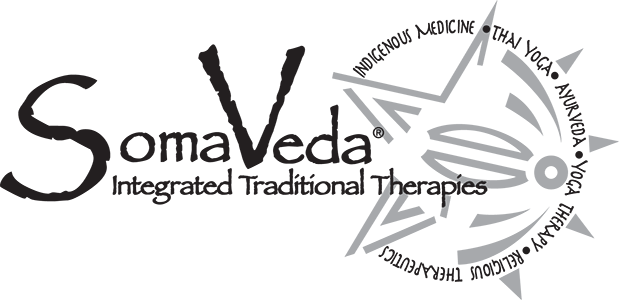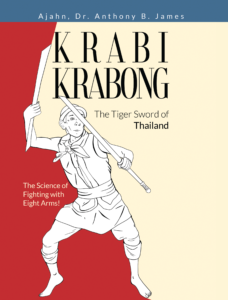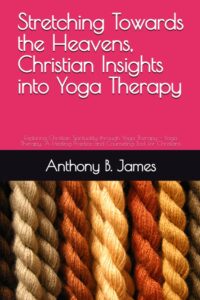
What are the additional expected benefits of SomaVeda® Thai Yoga Programs and Therapy?
The secondary/ incidental outcomes are of lesser importance and may or may not share characteristics similar to or common to many Western massage and massage therapy forms. Some hands-on are similar to effleurage (stroking and kneading the muscles), manipulation (manipulating or aligning osseous or skeletal parts), and pressure point or acupressure style technique (applying deep, consistent pressure to specific nerves, tendons, or ligaments and acupoints or Lom).
ITobalance the functions of the Four Ayurveda Dosha or body elements called thâat tháng sìi (Thai Lang.) (Lom, Fai, Din, Naam), SomaVeda® Thai Yoga incorporates elements of Prayer, Energetic and Prana Assessment, Mindfulness, Gentle Rocking, Asana Positional Release, Deep Stretching, Focused Breathing or Prana Yama, Chakra balancing, Prana Nadi or Sen Line Balancing, Dancing, Recitation of Sacred Mantra, Dancing Meditation and Dance Therapy (Flow/ Vinyasa), Movement Re-patterning and Rhythmic Compression to create a singular healing experience. It is pretty common for sessions and programs to be performed with music. SomaVeda® Thai Yoga, a traditional form of Yoga practice and therapy, also incorporates Ayurvedic Medical Herbology (sacrament), Pancha Karma Detoxification, Meditation, Blessing, and healing prayers in its great toolbox of healing modalities.
Thai Yoga Ayurveda Textbooks: For more specific details, I recommend reading the reference textbooks “Ayurveda of Thailand” and “Ayurveda and Thai Yoga, Religious Therapeutics Theory and Practice.”
Where Can I Learn Thai Yoga and Traditional Thai Massage?
1) The Native American Indigenous Church (N.A.I.C.) provides a registry of approved schools and teachers of SomaVeda® style Thai Yoga, Thai Massage, and Authorized and Approved Certified Providers.
N.A.I.C. Members are legally entitled to practice SomaVeda® Thai yoga massage in all fifty states. Of course, that means as long as what is practiced does not violate existing medical laws or the practice is under the umbrella of an ecclesiastical authority or organization. We are happy to answer any questions about the legal practice of our energetic and spiritually-based art of healing and transformation.
2) The Thai Yoga Center: In the U.S. today, the traditional lineages of Thai Yoga and Thai Massage are passed on via the in Brooksville, Florida through the Mastery and teaching of Aachan, Dr. Anthony B. James D.N.M(.P), N.D. (T), D.O.M., Ph.D., M.D.(AM), D.P.H.C.(h.c.), M.Sc., R.A.A.P., SMOKH. Ajahn, Dr. James, Ordained Minister, Diplomat, and Licentiate Monastic physician, after 34 plus years of extensive devotion, practice, and research, brings several different and complimentary traditional lineages to life.
• Phra Wat Chetuphon (Buddhist Temple, Wat Po Traditional Thai Medical School…One of the oldest schools of traditional arts)
• Buntautuk Hilltribes Northern Provincial Hospital and Training Institute is known as “The Old Medicine Hospital of Shivago Komarpai.”• ITM (International Thai Massage, Chiangmai)
• Mama Lek Chaiya
• The Foundation for the Blind
• Aachan Tawee: Buddhist Temple Wat Sawankholok, School for the Blind
There are several other significant lineages, teachers, and Grand Masters. Most important is the Buddhist medicine derived from the famous Saint Shivago (Jivaka). In the United States, traditional lineage and teaching are primarily passed on via the educational programs of the S.C.N.M.: American College of Natural Medicine/ School of Ayurveda: Thai Yoga Center in Brooksville, FL.
We recognize all schools formally recognized by the Royal Thai Ministries of Health and of Education and The Union of Thai Traditional Medicine Society (U.T.T.S.) listed or not!
There are many different traditional “schools” of Thai yoga massage. They range from the big university-driven or supported programs of Bangkok to the “family” style oral and traditional lineages of Thailand’s Northern Hill Tribe people, such as Karen, Lisu, Lahu, Mien, and Akha. Their influence is a growing factor in the modern expression of Thai Massage, especially in the North.
Thai Yoga is an every day or geographically unique system. Modern Thai yoga “massage” synthesizes several different regional variations based on location, region, and, in some cases, the specific influence of a charismatic teacher. Traditionally, there was mention of the “Seven Schools.” Of course, there were not in the past only seven schools! Considering this was the primary medicine of millions of people for over a thousand years, it is logical to assume there were many different schools in operation at one time or another. For example, every temple teaching or practicing these healing arts could have been considered a school; there were hundreds, if not thousands, of these over the years.
The most famous traditional school in the North is The Buntautuk Northern Hill Tribe Medical Hospital or “The Old Medicine Hospital.” Renowned schools and head Masters, such as Anantasuk Rongrian under Phaa Kruu Anantasuk and Aachan Nantipa Anantasuk, work with the King’s Rajaprajanugroh projects to thoroughly document the traditional medicine and preserve its rich heritage. Under Grand Master Aajan Sintorn Chaichagun (Transitioned November 2005), it has become a national and international phenomenon. Teaching various levels of programs to Thai and farang (foreigners) alike, Aajan Sintorn was also famous for his daily recitation of the Pali Om Namo Shivago prayer and invocation for blessing. Twice daily, he would lead the entire community in this rhythmic and beautiful traditional mantra for healing. In the North, they say, “You don’t know Thai Massage until you know this mantra!” Today, the Wat Po Association of Traditional Doctors, member schools, and Ajahn’s or Master Instructors are bringing this work into the modern world.
Northern Thailand is closer to mainland China, so more Chinese and Laotion-influenced massage techniques exist. For example, a well-known teacher and practitioner in Chiangmai, Mama Lek Chaiya, and her family teach “nûat jàp sên” (nerve-touch massage. This Chinese-style massage technique, like acupuncture, works with the body’s nerve meridians. Some plucking methods are reminiscent of Tuina and can be pretty unpleasant. However, the ultimate aim of balancing the chi takes precedence over comfort!
It is important to remember that any applications of physical pressure are intended to convey the ProMiiwihan Sii to balance and harmonize the “thâat tháng sìi” and Tri_dosha or Three Winds, Humor or energetically based body types. Thai Yoga is a sophisticated system of exchanging love with pressure, as a hug can convey care, consideration, and love with physical force. It’s just that in Thai Yoga that loving embrace is told with great detail and sophistication.
The practice of Thai Yoga is substantially based on principles of classical Ayurveda as described in the Caraka Samhita Sutra, Susrita Samhita Sutra, Gheranda Samhita, Atharvaveda, Pradipika, and Ramayana, without most of the overt references to Hindu deities. Ayurvedic practices emphasized in Thai Yoga include Samkhya (Sanskrit= Satkhya), Creation Cosmology, Rajas, Satvas and Tamas, Dhatus, Doshas, Sen Lines (Prana Nadi), Lom (Wind Gates, Sanskrit= Marma), Pancha Karma, Asana, Prana Yama, and Mantra. The philosophies and principles of these Ayurvedic texts have also been re-interpreted in Theravada Buddhism. Two influential texts in the Theravada system are the Buddha Dharma and the Vipassana Bhavana.
The four Thai Ayurvedic elements are earth (din-solid parts of the body, including nerves, skeleton, muscles, blood vessels, tendons, and ligaments); water (náam-blood and bodily secretions); fire (fai-digestion and metabolism); and air (lom-respiration, and circulation). Borrowing from India’s Ayurvedic tradition, some practitioners employ Pali-Sanskrit terms for the four bodily elements: pathavidhatu, apodhatu, tecodhatu, and vayodhatu. The book “Lines, Wheels, Points and Specific Remedies” covers this theory in detail.
Thai Yoga Therapy and or Thai massage (Traditional Thai Massage) are systems of yoga therapy, and all aspects of Somaveda® Thai Yoga follow Ayurvedic and yogic principles.
From the Ayutthaya period until early this century, the Thai government’s Department of Health included an official massage division (phanâek mãw nûat). Under the influence of international medicine and modern hospital development, the national propagation/maintenance of temple-based Thai Ayurveda was eventually transferred to Phra Wat Chetaphon (Wat Pho) in Bangkok, where it remains today. Traditional Yoga therapy has persisted in most provinces and has recently grown in popularity nationwide. The Wat Po system is divided into two separate and distinctive categories: the tourist massage pavilion and Tourist massage school (Rongrian Sala Thaang Nuat) and the School for Traditional Medicine for training and certification of Maw Nuad (Massage Doctors). There are considerable differences in the terms and quality of movement. For example, a tourist may receive an introductory massage certificate in as little as ten days. In contrast, the whole program for Maw Nuad is twelve to fourteen semesters or four full years. In the United States, we have many different levels of recognition for Certified Thai Yoga/Massage Practitioners.
The Royal Thai Ministry of Health relies on the Union of Thai Traditional Medicine Society (U.T.T.S.) to formulate and maintain standards of practice and competency necessary for the formal licensing of secular, non-religious professional Traditional Thai Medicine providers in the kingdom.
Within the traditional Thai medical context, a Thai Yoga massage therapist (mãw nûat, literally, ‘massage doctor’) usually applies Thai Yoga together with pharmacological (herbal) and psycho-spiritual treatments as prescribed for a specific problem or specific imbalance of the Dosha or winds and humor of the body, mind, and spirit. It is becoming quite popular for many Thais to use traditional Thai Yoga as a relaxation and disease prevention tool rather than for a specific medical problem. However, once you leave the big city and move into the country, you will see more reliance on energy-based medicine. This includes the resurgence and growing popularity of the self-treatment regimes and Yoga practices of “Reusi Dotan” or Reishi Yoga.
Thai Yoga (Thai Massage: slang), SomaVeda® Thai Yoga Therapy Are NOT Massage or Massage Therapy!
The term “Thai Massage” is Western slang, promoted mainly by tourists in Thailand. Although time is now standard, it is still misunderstood and misused by the misinformed. It is easy to be confused when similar words, such as “Massage,” but legally, there are distinctions and differences in definitions. Thai Yoga, Traditional Thai Yoga, and “Thai massage” are not the same as “Massage,” “Massage Therapy,” or “bodywork,” as commonly defined in so-called “Massage Laws.”
Please note: In everyday English, when we use the word “massage,e,” we do not mean it in the same context as the typical Western usage. In the West, “Massage” means something like a “rub down” for money or “Systems of activity applied to the soft tissues of the human body for therapeutic, educational, or relaxation purposes” and primarily referring to mechanical and or manipulative systems derived from Swedish Massage and Massage Therapy. “Thai Yoga and or Thai Massage” (Phaen Boran Ráksãa Thaang Nûat) is entirely unrelated!
Legally, words can have different meanings than words used in common, non-legal language. For example, “Massage and Massage Therapy” definitions are based on the practice of “Swedish massage.” “Swedish Massage” is new (less than one hundred years) in European and American culture. According to the National Center for Complementary and Alternative Medicine, “The term “massage therapy” encompasses many different techniques (see box for examples). Therapists press, rub, and otherwise manipulate the body’s muscles and other soft tissues. They often use their hands and fingers but may use their forearms, elbows, or feet”.
Compare this definition with the definition given for Thai Yoga at the beginning of this article: “Thai Yoga is comprehensive, sophisticated spiritual, philosophical and energy-based healing arts derivative of Theraveda Buddhism, Buddhist medicine, Buddhist Psychology, Theraveda Vipassana Bhavana, Classical Indian and Tibetan Ayurveda and Yoga Vedanta. ”
Thai yoga therapy (Thai Massage) sounds similar to Western-style massage at first glance, but what is not mentioned in the proceeding definition is that Indigenous Traditional Thai Massage (ITTM/ TTM) is a spiritual, i.e., Ayurveda-based system of healing and movement education (Yoga). It is based entirely on principles of Classical Indian/ Thai Ayurveda, energy balancing (Thai Sen lines, Tri-Dosha, Lom, Chakra, etc.,) and the actual touching, contact, or soft tissue manipulation is incidental to, and not the central aim of the practice! Again, I want to emphasize this statement: “It is possible to have a Thai Yoga session with little or no actual touching.” However, touching is good! Many spiritual traditions demand believers and followers to “Lay Hands On The Sick, Lame, Blind, Deming” as a sacred duty and responsibility. This work brings fundamental elements and energy into harmony, creating wholeness of mind, body, and spirit.
Thai Ayurveda, Thai Yoga (traditional thai massage) is a spiritually based Chirothesia and or Somatic technique and profession, a modality with standards established in the Buddhist holistic centers and temples thousands of years ago. It has a documented code of ethics known as the Buddha Dharma, The Eight Fold Path, Ahimsa (non-violence), and the “Ten Rules of the Healer.” The Native American Indigenous Church has adopted this healing tradition as an Indigenous Traditional Native Medicine as it is ideally suited for both Native and non-native persons alike to share and practice. Both U.N. and International Treaties and the U.S. Federal code protect traditional Indigenous Medicine and healing practices. See N.A.I.C. Legal Compliance.
There is an established criterion for education and professional practice for services that were never intended to be “Massage” or “Massage therapy.”
Although we teach and practice SomaVeda® Thai Yoga as a Christ-centered spiritual healing modality, we do not require nor promote its practice as exclusive of any faith or religion. Thai Yoga is suitable as a non-sectarian healing practice for persons of any faith or belief.
For a deeper dive into the history of Traditional Thai culture and Indigenous Traditional Thai Medicine, look at “Krabi Krabong, The Tiger Sword of Thailand. by Ajahn Dr. Anthony B. James.“

For a deep dive into Yoga Therapy’s and Ayurveda’s Christian roots, look at the new book “Stretching Towards The Heavens, Christian Insights into Yoga Therapy by Ajahn, Dr. Anthony B. James.”

SomaVeda Integrated Traditional Therapies®, SomaVeda® is a Federally Registered Trademark/ Servicemark and proprietary Intellectual Property, All World Rights Reserved.
